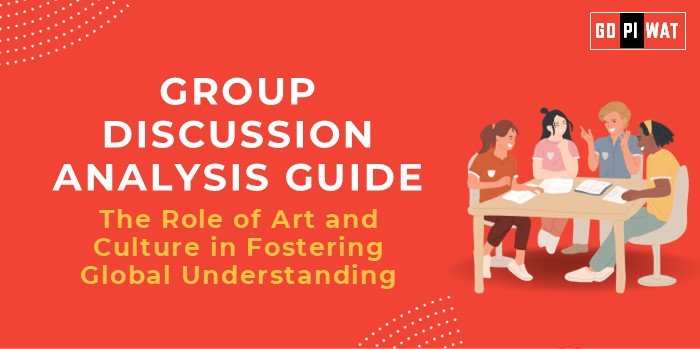📋 Group Discussion (GD) Analysis Guide: The Role of Art and Culture in Fostering Global Understanding
🌐 Introduction
- 💡 Opening Context: In an increasingly interconnected world, art and culture play a pivotal role in bridging differences, fostering dialogue, and promoting mutual understanding. Their universal appeal transcends language and political barriers, creating opportunities for collaboration.
- 📜 Topic Background: Art and culture have historically been tools for diplomacy and peacebuilding, from the Silk Road exchanges to UNESCO’s cultural preservation initiatives. In today’s globalized era, cultural festivals, international art collaborations, and digital platforms have amplified their impact.
📊 Quick Facts and Key Statistics
- 🌍 Global Cultural Trade: Cultural goods trade reached $116 billion in 2021, highlighting its economic and diplomatic relevance (UNESCO).
- 🏛️ UNESCO World Heritage Sites: Over 1,157 globally, representing shared human history.
- 🎭 Cultural Tourism: Accounts for 40% of global tourism revenue, reflecting its unifying appeal.
- 🎨 Art Markets: Global sales crossed $67.8 billion in 2022, reflecting cross-border artistic exchanges.
👥 Stakeholders and Their Roles
- 🏛️ Governments: Promote cultural diplomacy and exchange programs.
- 🎨 Artists and Creatives: Create works that challenge stereotypes and open dialogue.
- 🌐 International Organizations: Facilitate collaboration (e.g., UNESCO, World Heritage programs).
- 🏛️ Cultural Institutions: Organize exhibitions, festivals, and educational programs.
- 🌍 Global Audiences: Act as participants and advocates for cultural diversity.
🏆 Achievements and Challenges
✨ Achievements
- 🤝 Cultural Diplomacy: Initiatives like the Fulbright Program and UNESCO’s World Heritage listing foster collaboration.
- 📱 Digital Connectivity: Platforms like Instagram and YouTube democratize access to diverse art and cultures.
- 🎭 Cultural Festivals: Events like the Venice Biennale unite global artists under one roof.
⚠️ Challenges
- 🌍 Cultural Homogenization: Globalization risks overshadowing local traditions.
- ⚔️ Political Conflicts: Cultural exchanges may falter during geopolitical tensions.
- ⚖️ Access Inequality: Many regions lack the resources to showcase their heritage.
🌍 Global Comparisons
- 🇯🇵 Success: Japan’s “Cool Japan” strategy promotes its culture globally.
- 🇦🇫 Challenges: Afghanistan’s heritage sites face destruction due to instability.
📚 Case Studies
- 🎨 Kerala’s Biennale: International artists converge to celebrate local-global art.
- 🏛️ France’s Cultural Diplomacy: Louvre Abu Dhabi exemplifies cross-border cultural collaboration.
💬 Structured Arguments for Discussion
- 💪 Supporting Stance: “Art and culture foster empathy by showcasing diverse perspectives, strengthening global cooperation.”
- ⚖️ Opposing Stance: “Economic disparity and cultural appropriation undermine the effectiveness of such exchanges.”
- 🤝 Balanced Perspective: “While art and culture are powerful unifiers, their potential hinges on equitable access and respectful exchanges.”
📚 Effective Discussion Approaches
- 💡 Opening Approaches:
- 🎭 “Art transcends language, creating a universal platform for dialogue amidst global conflicts.”
- 🎥 “Cultural festivals like India’s International Film Festival illustrate the power of art in global outreach.”
- 🤔 Counter-Argument Handling:
- ⚖️ Example: “Addressing cultural appropriation through intellectual property laws can balance cultural exchanges.”
🔎 Strategic Analysis of Strengths and Weaknesses
- 💪 Strengths: Unifying potential, rich global heritage, economic impact.
- 🛑 Weaknesses: Geopolitical influences, commercialization risks.
- 🌟 Opportunities: Digital tools, cultural tourism, youth engagement.
- ⚠️ Threats: Conflicts, cultural dilution, resource limitations.
🎓 Connecting with B-School Applications
- 📊 Real-World Applications: Potential for CSR initiatives, tourism projects, or art market analytics in business projects.
- ❓ Sample Interview Questions:
- 💡 “How can businesses integrate cultural understanding into global strategies?”
- 🌍 “What role does art play in addressing global challenges like climate change?”
- 📝 Insights for Students:
- 🌎 Emphasize cultural intelligence in leadership.
- 🎨 Leverage art for community-building initiatives.


